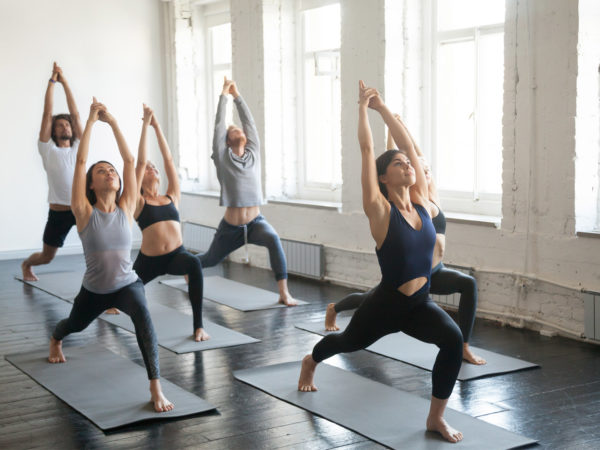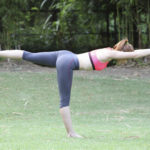The 8 Most Popular Types Of Yoga

Yoga offers many health benefits such as improving flexibility, reducing stress, and improving overall wellness and physical fitness. It is a wonderful mind-body activity that promotes relaxation as you practice linking breathwork to asanas (or poses). Additionally, recent research has also linked the benefits of all types of yoga to increased bone density and improved sleep quality.
As yoga has grown into mainstream popularity, many styles and variations have emerged into the wellness space. This centuries-old Eastern philosophy is everywhere now, being performed and taught by people of all ages, sizes, and backgrounds. With so many different types of yoga, it can be a little overwhelming deciding which style is right for you. It’s helpful to ask yourself what is important to you in a yoga practice: Are you looking for a sweaty, athletic workout, or does a more meditative, gentler approach sound more attractive?
Keep in mind that there is usually a fair amount of crossover among the various yoga styles, as well as diversity in teaching approaches within each discipline. Try exposing yourself to different types of classes and instructors to discover the right match for you.
Eight Types Of Yoga To Consider
Hatha
Hatha yoga is a standard term that includes most yoga styles that combine breathwork with physical postures. The term is broadly used, but typically involves a gentle introduction to basic yoga postures for beginners or those who prefer a more relaxed style. You probably won’t leave a hatha yoga class sweaty and tired, but you should end up feeling more relaxed and stretched out. Hatha classes may vary so it is best to call and inquire with the gym or studio offering the class.
Vinyasa
Vinyasa-style yoga combines rhythmic breathing with a series of flowing postures for a vigorous mind-body workout. Since it links breath to movement, vinyasa yoga is fluid and quickly paced – perfect for those looking for something athletic and dynamic. Vinyasa yoga can also be called power yoga, depending on the gym or studio. Expect to move to upbeat music, sweat, and burn some calories in this type of yoga!
Ashtanga
Ashtanga is very similar to vinyasa yoga, in rigor and style as both link breath to movement. Sometimes both terms are used interchangeably, but traditional ashtanga is more structured. It follows a specific sequence of poses in the exact same order, ideal for those looking for something predictable.Expect ashtanga to be hot, sweaty, and physically demanding. This is best explored if you are used to a vigorous workout and is not intended for someone just starting to become more active.
Iyengar
Iyengar is a meticulous style of yoga, giving emphasis to proper form in a yoga pose. An Iyengar class will usually provide an array of yoga props – blocks, straps, bolsters, blankets, etc. – to help each student find proper alignment. It is also usually taught without music and at a slower pace to help students get deeper into the postures and hold them for longer. This style of yoga is best for those with an injury or chronic condition, as Iyengar teachers must undergo comprehensive training to provide knowledgeable instruction.
Kundalini
Kundalini focuses on repetitive movements synchronized with the breath, along with chanting and meditating. The practice focuses on awakening the energy at the base of the spine in order to draw it up through each of the seven chakras (areas of energy throughout the body). Expect to chant mantras such as “Sat Nam” (meaning “I am truth”) and practicing more simple poses, while focusing your energy on awareness of both body and mind.
Bikram
You can be assured of two things when attending a Bikram class – sweat and consistency. A Bikram class is the same no matter where you go, as it consists of a series of 26 poses done in a specific order for 90 minutes in a room heated to 105°F (40.6°C), with a humidity of 40%. It’s wildly popular and relatively easy to find, but is not recommended for those with sensitivity to heat. Pre-hydration and post-hydration along with electrolyte replacement after this workout is advised to prevent fluid/electrolyte imbalances. It is also important to guard against over-straining your muscles and joints beyond what is comfortable due to increased flexibility with heat. Caution is also advised for those who are already overly flexible (Ehlers Danlos Syndrome). Classes are usually taught in a bright room with students facing mirrors to check proper alignment in the poses. If you’re looking for a disciplined yoga practice without music and want to know what to expect every time, this is the style for you.
Jivamukti
Jivamukti yoga incorporates vinyasa-style flow through movement along with weekly themes, Sanskrit chanting, meditation, readings and affirmations. Classes typically begin with a standardized warm-up sequence unique to Jivamukti and end with students adding to their broad yoga education overtime. Each week there is something new to learn whether its focusing on a particular asana (pose) or discussing an ancient yoga teaching. If you’re looking for something highly meditative, but also physically challenging, consider trying Jivamukti.
Yin/Restorative
Yin yoga is a slow-paced style that is meant to be meditatitive and relaxing. It is often interchangeable with “Restorative” yoga as both typically use props to experience yoga in passive poses for several minutes. The focus is to lengthen the connective tissue – the tendons, fascia, and ligaments – in order to improve flexibility and increase circulation in the joints. Expect to hold poses for longer than usual (three to five minutes). This class is great to unwind after a long week or weekend and suitable for everyone looking to feel rejuvenated and relaxed.
A Final Note on the Types of Yoga
There are many more types of yoga practices and each one offers something for everyone. When you find a type or a studio or instructor style that works for you, stick with it. Incorporating yoga into your life with dedication and consistency will allow you to reap the many benefits, both mental and physical.
If you are trying something new, come to class with an open mind and be sure to notify your instructor if you have any chronic pain, injury, or condition that would require modification. They can’t help you if they don’t know! It is key to release any expectations and explore different styles as your body and soul may need depending on your life or schedule. Yoga provides many benefits and its emerging popularity is a wonderful practice to incorporate into your life for physical, mental, and spiritual balance.















